Cultivated mushrooms
Some of the cultivated species

Agaricus bisporus
White button mushroom
The convex cap is white in color; the gills are free and initially pink, then dark brown or almost black. The cylindrical stem is thick and white; it bears an annulus at its midpoint.
It is the first cultivated mushroom; it is grown on pasteurized compost. In Spain, there are companies specialized in the production of compost and most of these are part of a cooperative of farmers.
The production of compost requires substantial investment in facilities and a technical team trained specifically in this field, therefore, white button mushroom producers cannot deal with this activity on their own.
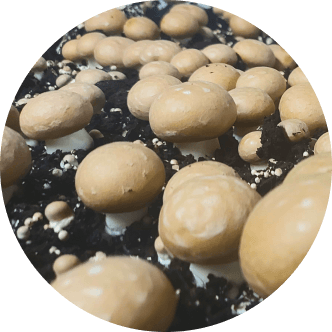
Agaricus bisporus
Portobello variety
When talking about its shape, it is similar to the white button mushroom. The convex cap is brown; the gills are pink and a white stem.
According to Singer Agaricus brunnescens, it is a synonym of the Agaricus bisporus and the Portobello, therefore it is of the Agaricus bisporus variety. Nevertheless, it is usual to find it as Agaricus brunnescens in some books.
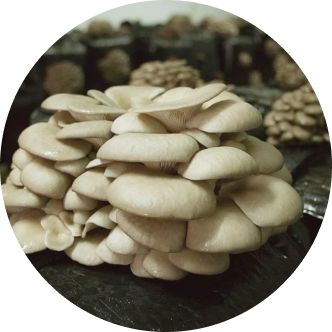
Pleurotus ostreatus
Oyster mushroom
The Pleurotus ostreatus bears fruit fruits (it produces mushrooms) in clusters or groups (several mushrooms together at the base). Oyster-shaped cap and the margin is inrolled, where the top of the cap ranges in color depending on environmental conditions or on its strain.
The size varies according to the strains used and the growing conditions. The gills are white to cream and descend on the stem decurrent. The stem is short and off-center, it is on the edge of the cap.
It is the second most cultivated wild mushroom in Spain after the white button mushroom. It is cultivated on pasteurized compost but it can also be grown on sterile substrate. The pasteurized compost allows for a bigger yield than the sterile one.
In Spain, there are companies specialized in the production of compost and most of these are part of a cooperative of farmers. A similar situation occurs in the development of compost for the oyster mushroom as for the white button mushroom, a substantial investment in facilities and a technical team trained specifically in this field is needed. The P. pulmonarius and P. cornucopiae are grown on the same substrate as the P. ostreatus.
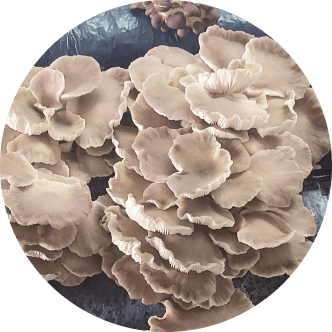
Pleurotus pulmonarius
P. Pulmonarius
It bears fruit in bunches or groups (several mushrooms connected at the base through their stem). It is very similar to P. ostreatus regarding flavor and cultivation.
It can handle higher temperatures than the P. ostreatus ,for this reason, P. ostreatus growers usually substitute for the P. pulmonarius in the hotter months.
This species can be grown in the same substrate as the P. ostreatus.
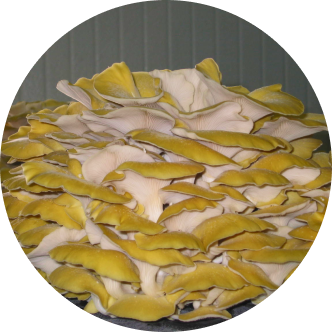
Pleurotus cornucopiae
P. citrinopileatus – Gold mushroom
It bears fruit in bunches or groups (several mushrooms connected at the base through their stem). The cap is a bright yellow in color, that is in the a funnel shape. The bright yellow cap contrasts with the white gills. Eccentric stem, elongated, white in color and with run down gills.
This species can be grown in the same substrate as the P. ostreatus. This mushroom is very brittle, so it must be collected very carefully.
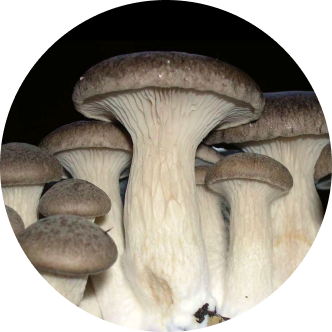
Pleurotus eryngii
King oyster
The cap is tan and it varies in color from cream to dark brown. The cap starts out round and as it grows, the cap flattens and sinks a bit in the center from convex to flat convex. The gills descend down the stem very decurrent. The stem is light in color, short and off-center , it can be completely on the edge of the cap.
There is a variety of king oyster which colloquially is called “Korean” due to its origin. It looks quite different than the varieties which are similar to the ones found in nature in the wild. The characteristic that makes it different is its stem because it is thick, long and often barrel shaped.
The cultivation of the P. eryngii is done on sterile substrate. If pasteurized compost is used, it is difficult to reach a stable output. In Europe, it is common to commercialize the sterile substrate used for the P. eryngii in 4 to 5 kilogram blocks, if it is of the compost pasteurized type, in 10 to 12 kg. blocks.
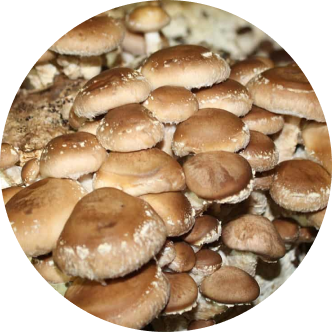
Lentinula edodes
Shiitake
The cap has a convex shape through most of its growth stage, and the cap flattens when it is mature. It is dark brown in the center, and it becomes discolored towards the edges with shades of ochre; the central area is flat and the rest gets coated with lighter scales than the original surface, flattish with not much relief. The stem is hard and much lighter than the cap.
The shiitake is originally from eastern Asia, and it is the most cultivated wild mushroom in the world – the white button mushroom is first. The shiitake is cultivated in many mushroom farms around the world. In Spain, it is the third most cultivated.
However it can be cultivated on pasteurized compost as well as sterile substrate. Both types of substrates adapt well to Shiitake production; to use one or the other depends on the production volume and the desired profitability.
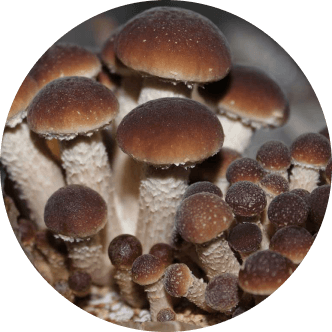
Agrocybe aegerita
Pholiota aegerita · Black poplar mushroom
It can be cultivated on pasteurized compost as well as sterile substrate, however it adapts better to the pasteurized compost; the mushrooms tend to be small with a low output when grown on the sterile substrate that we are familiar with.
The spawn smell of this mushroom draws many types of insects, which is a very important problem as it causes loses in the output.